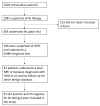Nickel Sensitivity Is Associated with GH-IGF1 Axis Impairment and Pituitary Abnormalities on MRI in Overweight and Obese Subjects
- PMID: 33419306
- PMCID: PMC7766406
- DOI: 10.3390/ijms21249733
Nickel Sensitivity Is Associated with GH-IGF1 Axis Impairment and Pituitary Abnormalities on MRI in Overweight and Obese Subjects
Abstract
Nickel (Ni) is a ubiquitous metal, the exposure of which is implied in the development of contact dermatitis (nickel allergic contact dermatitis (Ni-ACD)) and Systemic Ni Allergy Syndrome (SNAS), very common among overweight/obese patients. Preclinical studies have linked Ni exposure to abnormal production/release of Growth Hormone (GH), and we previously found an association between Ni-ACD/SNAS and GH-Insulin-like growth factor 1 (IGF1) axis dysregulation in obese individuals, altogether suggesting a role for this metal as a pituitary disruptor. We herein aimed to directly evaluate the pituitary gland in overweight/obese patients with signs/symptoms suggestive of Ni allergy, exploring the link with GH secretion; 859 subjects with overweight/obesity and suspected of Ni allergy underwent Ni patch tests. Among these, 106 were also suspected of GH deficiency (GHD) and underwent dynamic testing as well as magnetic resonance imaging for routine follow up of benign diseases or following GHD diagnosis. We report that subjects with Ni allergies show a greater GH-IGF1 axis impairment, a higher prevalence of Empty Sella (ES), a reduced pituitary volume and a higher normalized T2 pituitary intensity compared to nonallergic ones. We hypothesize that Ni may be detrimental to the pituitary gland, through increased inflammation, thus contributing to GH-IGF1 axis dysregulation.
Keywords: growth hormone deficiency; nickel sensitivity; obesity; pituitary morphology.
Conflict of interest statement
The authors declare no conflict of interest.
Figures


Similar articles
-
Overweight and obese patients with nickel allergy have a worse metabolic profile compared to weight matched non-allergic individuals.PLoS One. 2018 Aug 28;13(8):e0202683. doi: 10.1371/journal.pone.0202683. eCollection 2018. PLoS One. 2018. PMID: 30153310 Free PMC article.
-
Severe growth hormone deficiency and empty sella in obesity: a cross-sectional study.Endocrine. 2015 Jun;49(2):503-11. doi: 10.1007/s12020-015-0530-0. Epub 2015 Jan 23. Endocrine. 2015. PMID: 25614038
-
Characterization of the hypothalamo-pituitary-IGF-I axis in rats made obese by overfeeding.J Endocrinol. 1996 Feb;148(2):347-53. doi: 10.1677/joe.0.1480347. J Endocrinol. 1996. PMID: 8699149
-
Klotho and the Growth Hormone/Insulin-Like Growth Factor 1 Axis: Novel Insights into Complex Interactions.Vitam Horm. 2016;101:85-118. doi: 10.1016/bs.vh.2016.02.009. Epub 2016 Mar 16. Vitam Horm. 2016. PMID: 27125739 Review.
-
Physiological regulation of the human growth hormone (GH)-insulin-like growth factor type I (IGF-I) axis: predominant impact of age, obesity, gonadal function, and sleep.Sleep. 1996 Dec;19(10 Suppl):S221-4. doi: 10.1093/sleep/19.suppl_10.s221. Sleep. 1996. PMID: 9085516 Review.
Cited by
-
Application of a Machine Learning Technology in the Definition of Metabolically Healthy and Unhealthy Status: A Retrospective Study of 2567 Subjects Suffering from Obesity with or without Metabolic Syndrome.Nutrients. 2022 Jan 15;14(2):373. doi: 10.3390/nu14020373. Nutrients. 2022. PMID: 35057554 Free PMC article.
-
Bone Quality Indices Correlate with Growth Hormone Secretory Capacity in Women Affected by Weight Excess: A Cross-Sectional Study.J Clin Med. 2024 Aug 27;13(17):5064. doi: 10.3390/jcm13175064. J Clin Med. 2024. PMID: 39274277 Free PMC article.
-
Obesity-Associated Hepatic Steatosis, Somatotropic Axis Impairment, and Ferritin Levels Are Strong Predictors of COVID-19 Severity.Viruses. 2023 Feb 9;15(2):488. doi: 10.3390/v15020488. Viruses. 2023. PMID: 36851702 Free PMC article.
-
Growth Hormone Secretory Capacity Is Associated with Cardiac Morphology and Function in Overweight and Obese Patients: A Controlled, Cross-Sectional Study.Cells. 2022 Aug 4;11(15):2420. doi: 10.3390/cells11152420. Cells. 2022. PMID: 35954264 Free PMC article.
-
Pituitary T1 signal intensity at magnetic resonance imaging is reduced in patients with obesity: results from the CHIASM study.Int J Obes (Lond). 2023 Oct;47(10):948-955. doi: 10.1038/s41366-023-01338-w. Epub 2023 Jul 21. Int J Obes (Lond). 2023. PMID: 37479795 Free PMC article. Review.
References
-
- Lubrano C., Saponara M., Barbaro G., Specchia P., Addessi E., Costantini D., Tenuta M., Di Lorenzo G., Genovesi G., Donini L.M., et al. Relationships between body fat distribution, epicardial fat and obstructive sleep apnea in obese patients with and without metabolic syndrome. PLoS ONE. 2012;7:e47059. doi: 10.1371/journal.pone.0047059. - DOI - PMC - PubMed
MeSH terms
Substances
LinkOut - more resources
Full Text Sources
Medical
Miscellaneous

